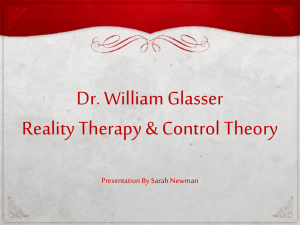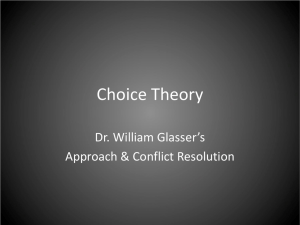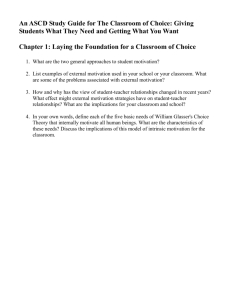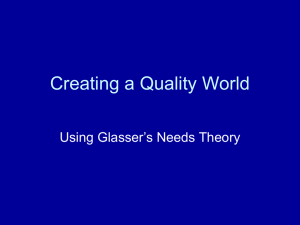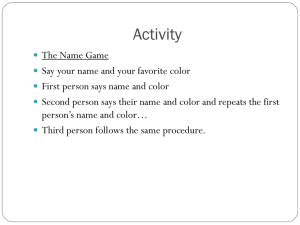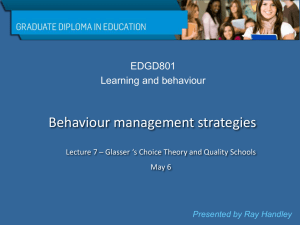chapter summary - Cengage Learning
advertisement
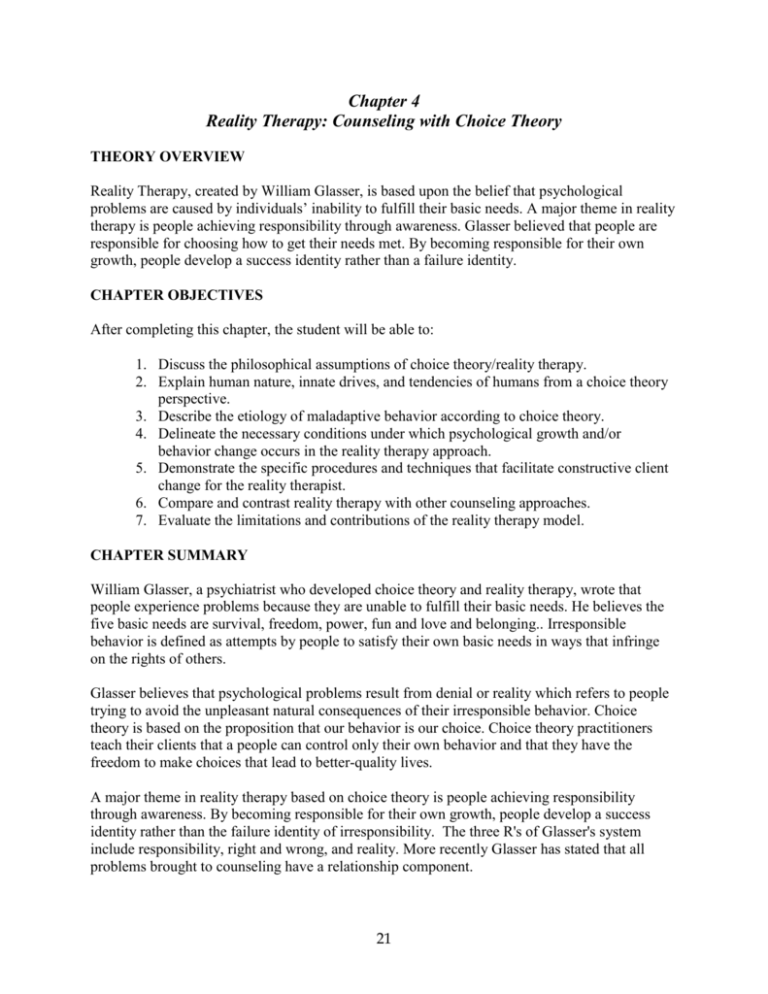
Chapter 4 Reality Therapy: Counseling with Choice Theory THEORY OVERVIEW Reality Therapy, created by William Glasser, is based upon the belief that psychological problems are caused by individuals’ inability to fulfill their basic needs. A major theme in reality therapy is people achieving responsibility through awareness. Glasser believed that people are responsible for choosing how to get their needs met. By becoming responsible for their own growth, people develop a success identity rather than a failure identity. CHAPTER OBJECTIVES After completing this chapter, the student will be able to: 1. Discuss the philosophical assumptions of choice theory/reality therapy. 2. Explain human nature, innate drives, and tendencies of humans from a choice theory perspective. 3. Describe the etiology of maladaptive behavior according to choice theory. 4. Delineate the necessary conditions under which psychological growth and/or behavior change occurs in the reality therapy approach. 5. Demonstrate the specific procedures and techniques that facilitate constructive client change for the reality therapist. 6. Compare and contrast reality therapy with other counseling approaches. 7. Evaluate the limitations and contributions of the reality therapy model. CHAPTER SUMMARY William Glasser, a psychiatrist who developed choice theory and reality therapy, wrote that people experience problems because they are unable to fulfill their basic needs. He believes the five basic needs are survival, freedom, power, fun and love and belonging.. Irresponsible behavior is defined as attempts by people to satisfy their own basic needs in ways that infringe on the rights of others. Glasser believes that psychological problems result from denial or reality which refers to people trying to avoid the unpleasant natural consequences of their irresponsible behavior. Choice theory is based on the proposition that our behavior is our choice. Choice theory practitioners teach their clients that a people can control only their own behavior and that they have the freedom to make choices that lead to better-quality lives. A major theme in reality therapy based on choice theory is people achieving responsibility through awareness. By becoming responsible for their own growth, people develop a success identity rather than the failure identity of irresponsibility. The three R's of Glasser's system include responsibility, right and wrong, and reality. More recently Glasser has stated that all problems brought to counseling have a relationship component. 21 Glasser’s views on the nature of people are based on these principles: The only person whose behavior we can control is our own. All long-lasting psychological problems are relationship problems that result from attempts of people to control other people. Past events have everything to do with what we are today, but we can satisfy our basic needs only in the present and we can make plans for the future. Satisfying the needs represented by the pictures of our quality world is the way we meet our needs for survival, fun, freedom, power, and love and belonging. Failure to meet these needs often results in choosing a symptom as a way of rationalizing or excusing this failure. Total behavior is all that we do, including acting, thinking, feeling, and physiology. We have direct control over acting and thinking; however, we can control our feelings and physiology indirectly by how we choose to act and think. The primary focus of choice theory is to prevent problems before they happen. Glasser believed that a good way to learn choice theory is to treat others in your life like you treat your best friend, your boss, and most strangers. You rarely try to force these people to do anything. Glasser identified three faulty beliefs of the control psychology that he says rules the world: (1) Much of my behavior is a response to an external signal, such as answering a ringing phone. (2) I can make people do what I want them to do even if they do not want to do it, and other people can control how I think act, and feel. (3) I have a right and a duty to punish those who do not do what I tell them to do and to reward those who do. Reality therapy includes an examination of the client’s belief system. Clients are challenged to prove the rationality of what they believe as well as the utility of what they do when they act on their beliefs. Each person has a quality world vision made up of pictures of the people we want to be with, the things we want to own and to experience, and the ideas or belief systems which govern our behavior. The closer our reality world approaches our quality world, the happier we will be. The idea is to place one’s quality world totally in one’s hands and not have quality world objectives under the control of others. The focus is on improving present relationships through personal change and disregarding past relationships. The success of the counseling process depends on creating a good relationship between the client and the counselor. Glasser outlined eight steps for the counselor in the reality therapy process: 1. 2. 3. 4. 5. 6. Build a good relationship. Examine the current behavior. Evaluate whether the behavior is helpful or not. Brainstorm alternatives. Make a commitment to try selected alternatives. At a later time examine the effectiveness of the commitment - no punishment and no excuses. 7. Accept the logical and natural consequences of the behavior. 8. Do not become discouraged. 22 Five questions (and statements) help expedite this process: 1. 2. 3. 4. 5. What are you doing? If you are ready to do this, we can begin by looking at what you have been doing to solve the problem. How is what you are doing helping you get what you want? It might be helpful to think about your behavior to see how each method is working for you. What might be some other things you could try? We could look at some new ideas to try when you are ready to look at moving toward a plan. Which idea would you like to try first? You have several possibilities. Tell me what you think about trying any of them? When? Let’s figure out when we can talk about whether your plan is working. Practitioners need to consider the concepts of reality, responsibility and right and wrong in Choice Theory in light of the developmental differences in young people’s moral development. Kohlberg identifies three stages of morality. Pre-convention morality involves sub-stages in which the person asks “Will I get caught?” and in stage 1 “What is in it for me?” Conventional morality includes stage 3 with “What will the neighbors think?” and stage 4 with “What is the rule or law?” Post-conventional morality incorporates stage 5 “What is best for society?” and stage 6 with “What is best for humankind?” Children’s reasoning about right and wrong may reflect those different questions. To summarize, reality therapy treatment is geared toward taking the steps needed to put clients on track to finding better ways in meet their needs. Just as the essence of life is building loving relationships and a solid career or other meaningful activities that contribute to society, the essence of choice theory/reality therapy is building and maintaining relationships and improving academic or career performance to meet one’s basic needs. A 10-step consultation model is presented. Cross-cultural applications and the place of reality therapy in a managed care environment are also discussed. KEY CONCEPTS 1. 2. 3. In reality therapy the concept of reality is defined as being willing to accept the natural consequences of our actions. In reality therapy the concept of responsibility is defined as the ability to meet one's own needs without infringing on the rights of others who are seeking to meet their needs. In reality therapy the concept of right and wrong is defined as something you know by how you feel. 23 4. 5. 6. In reality therapy the first step in the counseling process is the building of a warm, caring relationship with the child. Present behavior is identified and evaluated. A plan is made and the client makes a commitment to act on the plan. KEY TERMS, CONCEPTS, and PERSONALITIES Commitment – The process where the client dedicates himself/herself to the pursuit of his/her goals. Consequences – Logical and natural responses to specific behaviors. Choice theory – A philosophy that values individuals taking control of their life by being responsible for their own choice, decisions, and goals. Failure identity – The result of one’s inability to meet the need to be loved and the need to be valued. Reality – The willingness of the client to accept natural consequences of his/her behavior. Responsibility – The ability to meet one’s needs without affecting the ability of others to meet their needs. Success identity – The result of the attainment of the need to be loved and the need to be valued. REVIEW QUESTIONS 1. Glasser believed that psychological problems are the result of: A. irrational thinking. B. childhood experiences. C. an inability to fulfill one’s basic needs. D. an inability to control one’s behavior. 2. According to Glasser, what are the two primary traits of adjusted people? 3. A primary product of becoming a responsible person is 1. Glasser’s treatment plan focuses on teaching people to love and be loved and: A. to feel valued by oneself and others. B. to learn acceptable behavior. C. to learn to think rationally. D. to feel accepted by others. 24 . 5. Glasser’s “three R’s” are: A. reasoning, rationality, and reality. B. responsibility, right and wrong, and reality. C. reality, respect and right and wrong. D. responsibility, respect, and righteousness. 6. Glasser believed that people become mentally ill because: A. they behave irresponsibly. B. other people or events influence them negatively. C. they are destined from birth. D. they are, by nature, evil. 7. Reality Therapy is a A. healing B. guiding C. teaching D. curing process, according to Glasser. 8. List and explain the eight steps of reality therapy. 1. 2. 3. 4. 5. 6. 7. 8. ______________________________________________ ______________________________________________ ______________________________________________ ______________________________________________ ______________________________________________ ______________________________________________ ______________________________________________ ______________________________________________ 9. The first step in Reality Therapy involves: A. making a diagnosis. B. building a relationship. C. gathering information about the client’s past. D. having the client make a commitment to change. 10.One question a reality therapist might ask a client is: A. “Is what you are doing helping you get what you want?’ B. “Why are you doing what you are doing?” C. “What does your mother think about what you are doing?” D. “Who else does what you are doing?” 25 11.The reality therapist should, according to Glasser: A. work toward solving client’s problems. B. focus on behaviors impeding client’s progress. C. help clients to solve their problems themselves. D. reject any failed attempt by the client to change. 12. Which of the following is not true of reality therapy? A. The counselor does not accept excuses from the client. B. The client must take responsibility for his or her actions. C. Transference is a necessary aspect of therapy. D. Clients are asked to evaluate their actions. 13. Glasser believes that behavior is A. acting B. thinking C. feeling D. all of the above 11. A. B. C. D. Glasser states that all long-lasting psychological problems are relationship problems responsibility problems unconscious problems cognitive problems ESSAY QUESTIONS 1. In developing his theory, Glasser was reacting against traditional psychoanalytic therapy. Describe the major differences between the two theories. 2. Choice theory maintains that people are responsible for their own choices and goals, and therefore, for their own happiness. People choose whether or not to let external events and people affect them. Glasser would say that, instead of a person being depressed, a person is depressing. Explain his reasoning for that concept. 3. Use the reality therapy questions and write a script for a counseling session. 26 ACTIVITY 1. Glasser describes learning teams made up of two to five students which are designed to give students the responsibility for their learning while meeting their basic needs for belonging, power, friendship, and achievement. Create a plan for a classroom guidance lesson on any topic based upon this model. Include the topic to be addressed, the structure of the lesson, activities to be done, and how each of the four needs will be met. 2. Identify a problem you are currently facing in your life. Using the five questions in the text (The Reality Therapy Process), talk yourself through the reality therapy process. With a partner, discuss if and how these questions aided your understanding of this problem. What are your reactions to this process? 3. Use the 10-step consultation process to show how a teacher could be helped in working with a student who is always late. 27
